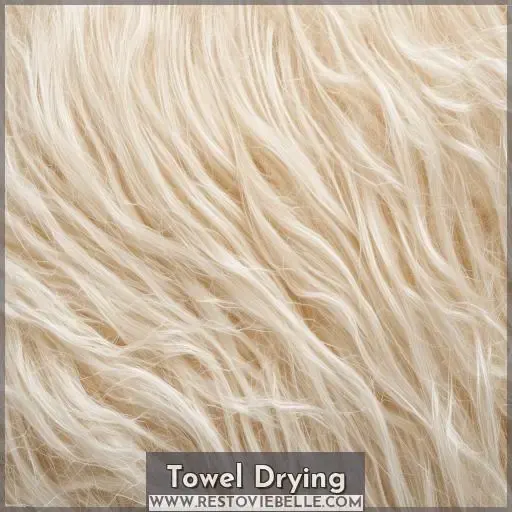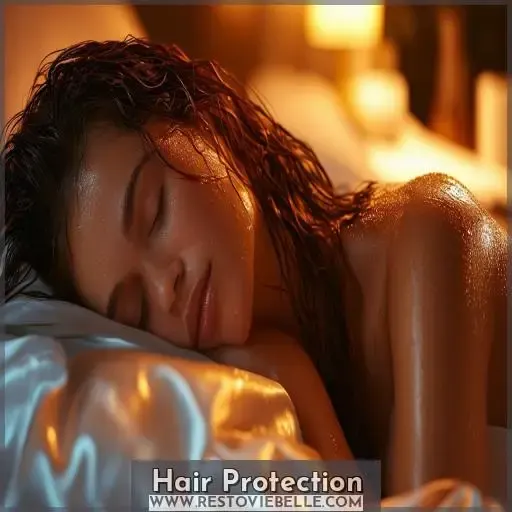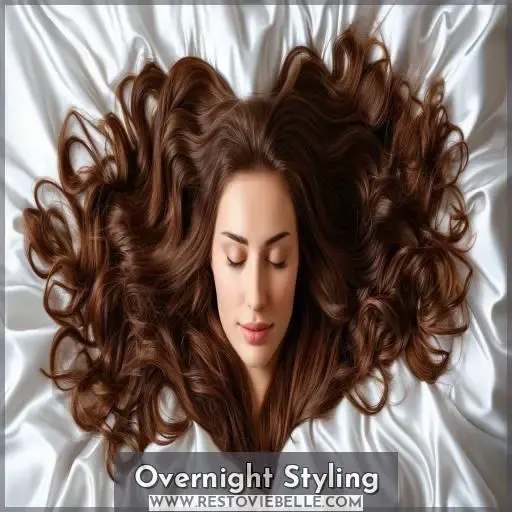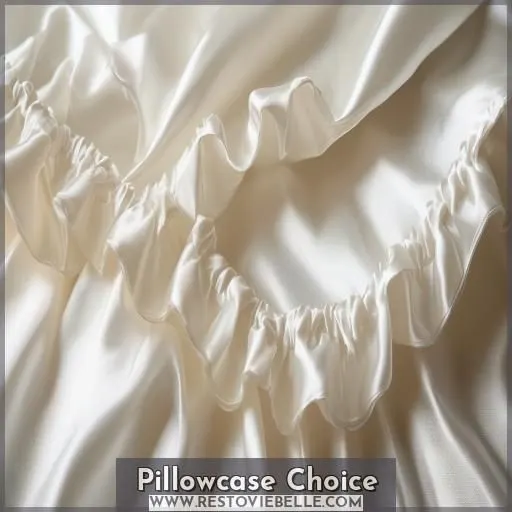This site is supported by our readers. We may earn a commission, at no cost to you, if you purchase through links.
 If you’re wondering how to sleep with wet hair, don’t worry—it’s doable with the right approach!
If you’re wondering how to sleep with wet hair, don’t worry—it’s doable with the right approach!
Gently blot excess moisture with a microfiber towel to avoid roughing up strands.
Apply a leave-in conditioner or lightweight serum to smooth the cuticle and minimize frizz.
Braid or loosely bun your locks to keep them contained overnight.
Finally, use a silk or satin pillowcase to reduce friction and preserve your hair’s natural texture.
With these simple tips, you can wake up with manageable, healthy-looking locks.
But for an even deeper delve into overnight hair care, keep reading.
Table Of Contents
Key Takeaways
- Gently pat your wet locks with a microfiber towel, never rubbing vigorously, to avoid frizz and breakage. As my grandma used to say, "Treat your hair like a delicate flower, darling!"
- Slather on a leave-in conditioner or lightweight serum to smooth those cuticles and keep your strands hydrated and happy overnight. Think of it as a cozy little blanket for your hair!
- Braid or loosely bun your damp ‘do before hitting the hay. It’ll keep your locks tamed and tangle-free, ensuring you wake up with gorgeous, defined waves or curls.
- Invest in a luxurious silk or satin pillowcase. Not only will it make you feel like royalty, but it’ll also minimize friction and frizz, so you can wake up with sleek, shiny tresses fit for a queen!
How to Sleep With Wet Hair?
To sleep with wet hair, you should gently towel-dry it and apply a leave-in conditioner or serum to minimize frizz and tangles. Braid your hair or put it in a loose bun, and use a silk or satin pillowcase to protect your strands overnight.
Towel Drying
Let’s start with towel drying – a crucial step to avoid unnecessary hair trauma.
Grab a thick, absorbent towel made from a soft fabric like cotton or microfiber.
Gently blot and squeeze your locks, never rubbing vigorously, as that can lead to breakage and frizz.
Take your time; rushing this process can cause scalp irritation.
The goal is to remove excess water without roughing up your delicate strands.
With the right towel and technique, you’ll be well on your way to beautiful, healthy hair come morning.
Product Application
You’ll want to apply a leave-in conditioner to help detangle and protect your damp locks overnight. A lightweight serum can also help minimize frizz and add shine while you sleep.
Leave-in Conditioner
After patting your hair dry, apply a leave-in conditioner to lock in moisture. It provides:
- Moisturizing benefits to nourish strands
- Frizz reduction for smooth, sleek locks
- Tangle prevention for easy detangling
Look for formulas with heat protection to style while you sleep without damage.
Serum
You’ll also want to apply a lightweight hair serum after your leave-in conditioner. Serums provide intense hydration, acting as a protective barrier against frizz and split ends overnight. Look for nourishing ingredients like argan or moroccan oil to lock in moisture while you snooze. A pea-sized amount evenly distributed can work wonders for sealing those cuticles until morning.
Hair Protection
To protect your hair while sleeping with wet locks, focus on minimizing frizz and preventing tangles overnight. Applying a leave-in conditioner or serum can help smooth the hair cuticle and reduce friction between strands.
Frizz Minimization
Air drying creates frizz, but saturating strands with leave-in conditioner or serum before bed locks in moisture, minimizing puffiness. Smart pillowcase choices like silk or satin also fight frizz – their smooth texture allows hair cuticles to glide effortlessly, preventing roughness. By protecting your locks from dryness and friction, you’ll wake up gorgeous, not frazzled.
Tangle Prevention
You’ll want to brush your hair before bed to prevent tangles. Avoid using a hair dryer, as the heat can cause more knots. Instead, apply a detangling spray and gently work out any snarls with a wide-tooth comb. Blotting your hair with a microfiber towel helps dry the roots, minimizing tangles overnight.
Overnight Styling
One of the best ways to protect your wet hair overnight is by braiding it into one or more plaits. This not just prevents tangles and frizz, but also helps preserve your hair’s natural texture and shape as it dries.
Braiding
Braiding damp hair before bed prevents tangling and breakage overnight. For looser waves, opt for a loose braid or two. Those with curlier textures may prefer multiple braids to encourage definition. Always braid gently, being mindful of tension on the scalp. Use a silk scrunchie or pillowcase to minimize friction and frizz.
Bun or Updo
An updo like a loose bun secured with soft scrunchies or bobby pins is another overnight style option. It keeps lengths contained while allowing airflow to help hair dry. For thick hair, try a high bun or loose chignon using a wide headband or soft hair wrap to prevent dents from sleeping on it.
Pillowcase Choice
In terms of pillowcase selection, opt for silk or satin as they create less friction and minimize frizz and tangles. Alternatively, absorbent cotton pillowcases can help wick away excess moisture from your hair as you sleep.
Silk or Satin
If you’re looking for a luxurious way to protect your damp locks, consider switching to a silk or satin pillowcase. These materials:
- Minimize friction and frizz
- Help retain moisture
- Reduce tangles and breakage
- Create a smooth, sleek finish
- Provide heat protection
With their smooth texture, silk or satin pillowcases are a game-changer for preserving your hair’s health and shine overnight.
Absorbent Cotton
If you prefer a more breathable option, an absorbent cotton pillowcase can help wick away moisture from your hair while you sleep. This prevents excess dampness, reducing the risk of hair breakage and scalp irritation.
However, cotton’s absorbency means you may need to re-wet your hair in the morning to restore moisture and manageability.
Consider your hair type and sleep quality when choosing the right pillowcase.
Frequently Asked Questions (FAQs)
Is it safe to sleep with wet hair?
Sleeping with wet hair isn’t ideal, but it’s generally safe. However, damp hair can lead to breakage, frizz, and an unpleasant smell from bacteria growth. For maximum hair health, it’s best to dry your hair thoroughly before bedtime.
How long does it take for hair to dry?
Like a rainforest after a storm, your hair needs time to dry. Around 3-4 hours for short cuts, 6+ for longer locks – but factors like humidity play a role. Embrace the moisture while you can; sleek, smooth strands await.
Can wet hair cause dandruff or fungal infections?
Yes, wet hair can lead to dandruff or fungal infections. The damp environment provides ideal conditions for fungi and bacteria to thrive, potentially causing scalp irritation and flaking. It’s best to dry your hair thoroughly after washing to prevent these issues.
Does sleeping with wet hair lead to hair loss?
You’re unlikely to lose hair from sleeping with wet locks occasionally, but frequently doing so raises risks like hair breakage and scalp issues. Gently towel-dry before bed for healthier strands.
Is it better to air dry or blow dry?
You’re better off air drying when possible. Blow drying can cause heat damage and dryness, especially if you overdo it. But if you’re short on time, use the cool setting and limit exposure.
Conclusion
A well-rested head of hair begins the night before – and with over 60% of adults sleeping with wet hair, safeguarding your locks overnight is essential.
Carefully towel drying, applying a nourishing leave-in, and styling in braids or buns minimizes frizz.
While using a silk pillowcase reduces friction.










